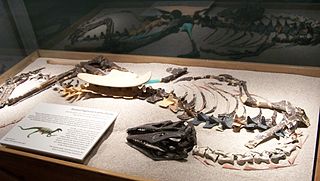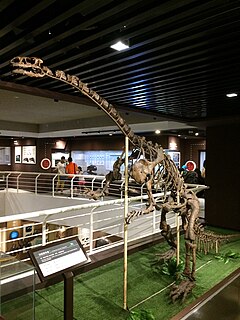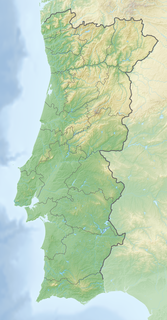
Coeluridae is a historically unnatural group of generally small, carnivorous dinosaurs from the late Jurassic Period. For many years, any small Jurassic or Cretaceous theropod that did not belong to one of the more specialized families recognized at the time was classified with the coelurids, creating a confusing array of 'coelurid' theropods that were not closely related. Although they have been traditionally included in this family, there is no evidence that any of these primitive coelurosaurs form a natural group with Coelurus, the namesake of Coeluridae, to the exclusion of other traditional coelurosaur groups.
Professor David Bruce Weishampel is an American palaeontologist in the Center for Functional Anatomy and Evolution at Johns Hopkins University School of Medicine. Weishampel received his Ph.D. in Geology from the University of Pennsylvania in 1981. His research focuses include dinosaur systematics, European dinosaurs of the Late Cretaceous, jaw mechanics and herbivory, cladistics and heterochrony and the history of evolutionary biology. Weishampel's best known published work is The Dinosauria University of California Press; 2nd edition. He consulted for Jurassic Park and is a good friend of Steven Spielberg. He has received an Academy Scientific and Technical Award.

Lufengosaurus is a genus of massospondylid dinosaur which lived during the Early Jurassic period in what is now southwestern China. A nearly intact lufengosaurus was found in May 2021 in Lufeng City, in the Province of Yunnan, in Southern China, by paleontologists and Wang Tao, Head of the Dinosaur Conservation and Research Center in Lufeng City. Again, the dinosaur made international headlines in 2017 when Nature Communications reported scientists' discovery of 195-million-year-old collagen protein in the rib of a Lufengosarus fossil.
Zigongosaurus is a genus of sauropod dinosaur from the Middle Jurassic-Late Jurassic-age Shaximiao Formation of Zigong, Sichuan, China. Because of incomplete knowledge of Jurassic Chinese sauropods, it has been hard to interpret, with some sources assigning it to Omeisaurus, some to Mamenchisaurus, and some to its own genus.
Taveirosaurus (tah-VAY-roo-SAWR-us) is a genus of ornithischian dinosaur that lived in Europe during the Late Cretaceous. The genus is based solely on teeth.
Gongbusaurus is a genus of ornithischian, perhaps ornithopod, dinosaur that lived between about 160 and 157 million years ago, in the Late Jurassic period. A small herbivore, it is very poorly known. Two species have been assigned to it, but as the original name is based on teeth, there is no concrete evidence to connect the two species. Its fossils have been found in China.

Kayenta, Arizona is a settlement in the Navajo reservation.

Halszka Osmólska was a Polish paleontologist who had specialized in Mongolian dinosaurs.
Teresa Maryańska was a Polish paleontologist who has specialized in Mongolian dinosaurs, particularly pachycephalosaurians and ankylosaurians. Peter Dodson claims that in 1974 Maryanska together with Halszka Osmólska were among the first "women to describe new kinds of dinosaurs". She is considered not only as one of Poland's but also one of the world's leading experts on dinosaurs.

Thecodontosauridae is a family of basal sauropodomorph dinosaurs that are part of the Bagualosauria, known from fossil remains found exclusively in the Magnesian Conglomerate of Bristol, England, which dates back to the Rhaetian stage of the Late Triassic. Two genera are known: Agrosaurus and Thecodontosaurus; the former is often considered to be the same animal as the latter.
The La Boca Formation is a geological formation in Tamaulipas state, northeast Mexico. It was thought to date back to the Early Jurassic, concretely the Pliensbachian stage epoch. Although, the latest studies had proven that the local Vulcanism, related to the aperture of the Atlantic Ocean and the several Rift Events, that continue until the Bajocian where developed until the Latest Pliensbachian, with tha fossil taxa deposited on the rocks above. Due to successions of Aalenian depositional sistems on the upper layers of the Huizachal Canyon, has been delimited the formation to the Toarcian stage, being the regional equivalent of the Moroccan Azilal Formation.

The Calcaire de Caen or Calcaires de Caen Formation; French for Caen Limestone, is a geological formation in France. It dates back to the mid-Bathonian of the Jurassic. It was often quarried for building work and is referred to as Caen Stone.

The Inferior Oolite is a sequence of Jurassic age sedimentary rocks in Europe. It was deposited during the Middle Jurassic. The Inferior Oolite Group as more recently defined is a Jurassic lithostratigraphic group in southern and eastern England. It has been variously known in the past as the Under Oolite, the Inferior Oolite, the Inferior Oolite Series and the Redbourne Group.
The Camadas de Guimarota, simply Guimarota, or Camadas de Alcobaça is a disused coal mine near the city of Leiria in central Portugal. The mine is within layers of the Alcobaça Formation, Kimmeridgian age of the Late Jurassic period, it contains a diverse array of fossil animals and plants, including dinosaurs and mammals.

The Shishugou Formation is a geological formation in Xinjiang, China.
The Tugulu Group is a geological Group in Xinjiang, China whose strata date back to the Early Cretaceous. Dinosaur skeletal remains and footprints are among the fossils that have been recovered from the formation.

The Tiourarén Formation is a geological formation in the Agadez Region of Niger whose strata were originally thought to be Early Cretaceous. However, re-interpretation of the sediments showed that they are probably Middle Jurassic (Bathonian) in age. It is the uppermost unit of the Irhazer Group. Dinosaur remains are among the fossils that have been recovered from the formation.

The Caranguejeira Conglomerate is an Aptian to Cenomanian geologic formation in Portugal. Dinosaur remains diagnostic to the genus level are among the fossils that have been recovered from the formation.

The Lianmuqin Formation, also transcribed as Lianmugin Formation, is an Early Cretaceous geologic formation composed of "interbedded red green and yellow variegated mudstones and siltstones". Dinosaur remains have been recovered from it.












